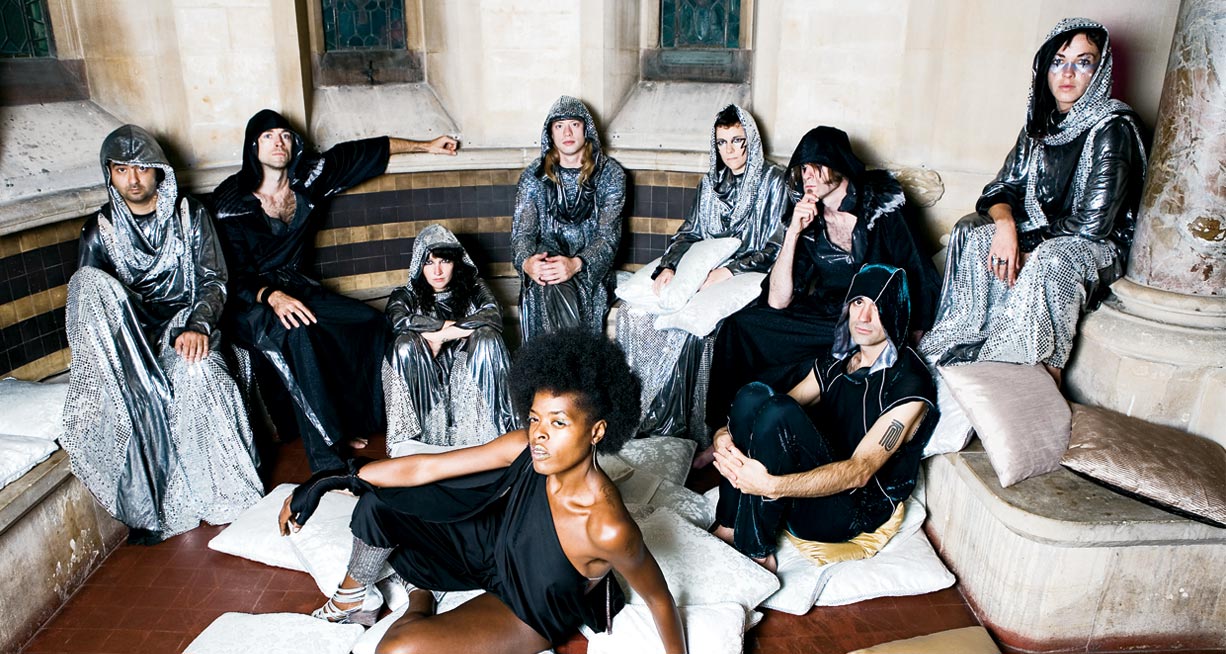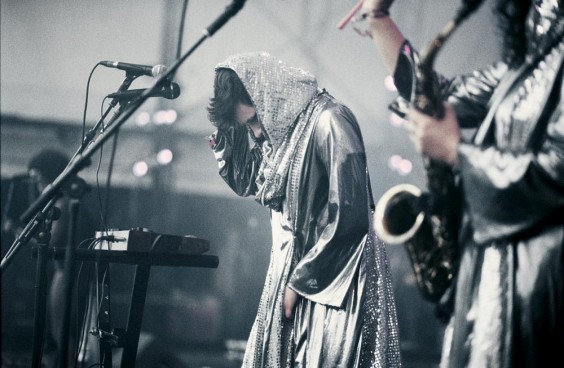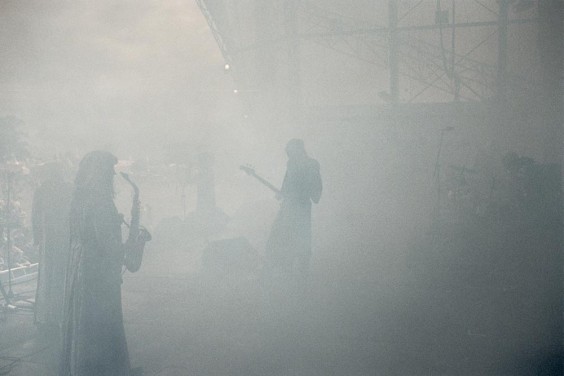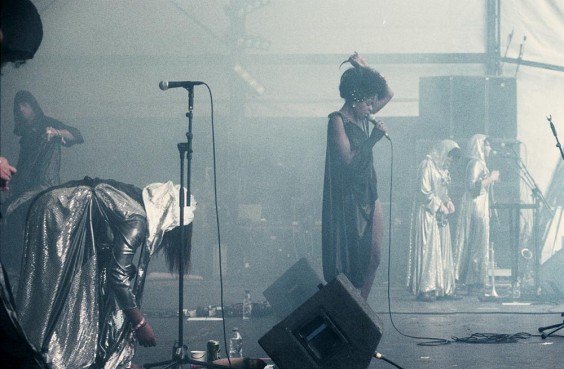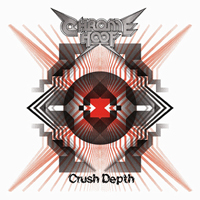 Chrome Hoof: Crush Depth (Southern Records, 7/6/10)
Chrome Hoof: Crush Depth (Southern Records, 7/6/10)
Chrome Hoof: “Crystalline”
[audio:https://alarm-magazine.com/wp-content/uploads/2010/12/Chrome_Hoof_Crystalline.mp3|titles=Chrome Hoof: “Crystalline”]Despite the sparkly silver cloaks and the monochromatic moniker, sterling is not the word that brothers Leo and Milo Smee use to describe their music. When asked where they would place themselves on the disco-chamber-doom-prog color spectrum, Milo chooses “an unpleasant magenta.”
Known for their flippant jokes, the Smees don’t apply an overly cerebral context to Chrome Hoof, their London rock ensemble of sci-fi sounds and occult vibes. Instead, the brothers direct serious energy toward producing a theatrical, stimulating live show. “We need to keep it fun and moving forward — especially with our low attention spans,” Leo says.
Originally formed as a duo with Leo on bass and Milo on drums, the Smees performed with a tape machine and a sampler to fill out the sound. Now a sprawling live incarnation of ten of more musicians, Chrome Hoof maintains a core of Leo and Milo with singer Lola Olafisoye of electronica funk band Spektrum. The logistics of coordinating such an impressive production can be trying, but they manage to pull it off with a deep roster of musicians.
“As long as me, Milo, and Lola are available, then we can make it work,” Leo says. “We’re not huge on rehearsals, but we for sure have to put work in. Most of the members have jobs, and with having so many members, if certain people can’t make shows, we either draft other floating members in, or just cover the missing instruments with synths.”
Performances include a wardrobe of the aforementioned glittery-hooded, cultish cloaks, dancing girls adding a touch of chaotic energy, accompanying lasers and fog, and, for a time, a seven-foot metallic ram. The spectacle of a Chrome Hoof show is almost as important as the music itself. “Having a visual aspect increases the experience — and helps us to get into character,” Leo says. “You have to be there one time to see what it’s about. A YouTube video can’t transmit the two-way energy that being at the show does.”
When making comparisons to their over-the-top performances, the brothers agree that there are plenty of theatrics in the rock arena. “We just saw Gwar,” Leo says, “but the idea of being on stage and entertaining seems to have dwindled. There’s a proliferation of four-boy outfits with trendy tattoos and tight jeans.”
Chrome Hoof’s third album, Crush Depth, released in May of 2010 on Southern Records, also bucks trendiness, garnering comparisons to iconic bands like Funkadelic, Slits, and Slayer. So what to make of such a disparate group? Though the band borrows liberally from a pool of eras and genres, to call them derivative or simply a musical collage would be missing the point. “I’m not sure there would be any band you couldn’t apply that [theory] to,” Milo says. “Everything has its roots in stuff that went before, but hopefully it’s apparent that we are trying to push forward in our own way.”
Questioned as to whether it is even possible to make music that isn’t derivative of something, Milo is honest and realistic: “I’d like to say yes,” he responds, “but I can’t think of anything to back it up. It’s our thing. The power of music is undeniable; that doesn’t apply to rock music any more than anything else — or any more to 2010 than 3009.”
Take Crush Depth’s seven-minute “Sea Hornet,” easily the most incongruent track on the album. Opening with a low cackle of voices, a bass line emerges aping the riff from Rush’s “YYZ.” A half-melted synthesizer line combines with a 16th-note hi-hat beat to turn the heavy throb on its head and into a loungy, Tortoise-style groove. Then triumphant strings and an ’80s whip-crack snare effect combine to form a pumping anthem. While the song fades out, unintelligible, whispered vocals hover over an extended cool-down. Though bordering on exhausting and indulgent, its clever calculations and undeniable sense of fun make “Sea Hornet” a standout track, incongruence and all.
Sharing a progressive, experimental approach to music, the band had the opportunity to play Magma’s 40th anniversary show with French composer Jean-Pierre Massiera in October of 2009. This led to Massiera’s contribution to the track “Towards Zero” on Crush Depth. Leo explains, “We wanted to do a cover version of ‘Visitors’ ages ago, so when we were asked to do a collaboration with Massiera, we jumped at the chance. We had a couple of rehearsals prior to the gig, but the only problem is that we had little knowledge of the French language, and Massiera [had even] with less English. He couldn’t remember a lot of his old tunes and had to be guided through the songs. He’s a live wire for sure, which only added to the feast. As we were working on the album, we thought it would be a cheeky opportunity to capture this legend on record. He was more than happy to shriek some guttural poetry on top of our music.”
Recording Crush Depth took about a year to complete. Over that period, Milo and Leo had quiet times where decisions could be delayed, which they say was useful in the process as parts were recorded at 50 locations with 70 people. “There was a 12-piece choir, harpist, maybe 10 people doing a bit of engineering here and there, back-up parts recorded to double certain lines, obviously the whole band, and quite a few guest musicians,” Milo says. Those guests include German experimental group Cluster on “Deadly Pressure,” an ominous Cthulu-rising space jam.
“[Songs] changed according to environments, availability of personnel, credit status, et cetera,” Milos says. “It was a fluid process. The time that we had meant we could try a lot of things out.” The long process also meant that the band was able to borrow lots of keyboards, a Mellotron, and “the overrated Moog Taurus.”
To explain the result of the extensive cast of collaborators and the amount of time spent creating Crush Depth, Milo uses a snack-cake analogy, comparing it to the band’s previous album, Pre-Emptive False Rapture: “It has more layers, like a foul Sara Lee cake. Pre-Emptive is more digestible — like a Mr. Kipling Almond Slice. Crush Depth is like the title — whatever you make of that. It’s more of an album to be played as a whole.”
Though the United States has waited for a proper release of Chrome Hoof’s material, it may take much longer for Americans to see Chrome Hoof in the flesh. After all, bringing together the sheer multitude of musicians, dancers, instruments, and props for a cross-Atlantic tour will only be resolved by a Herculean scheduling effort. But there must be hope for such a journey, because the band has proven, through its recordings and its legendary performances, that it is willing to go the extra mile.

